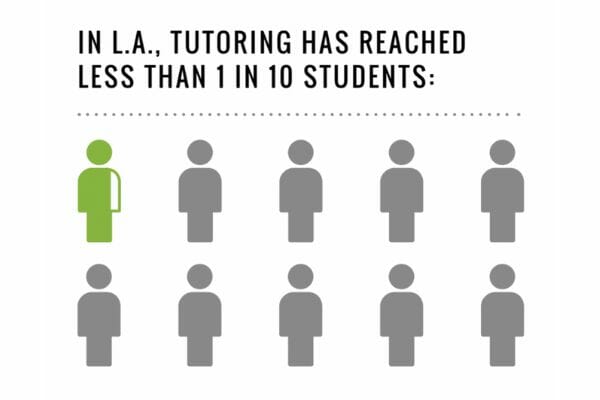To Address Pandemic and Teacher Shortage Impacts, LAUSD Students Need Tutoring Now
Students are becoming increasingly disengaged from school and falling further behind. More than half of Los Angeles Unified students have been chronically absent, and there were 420 unfulfilled teacher positions across the district. This only adds to the learning loss students experienced during school closures.
The teacher shortage has most harmed schools that serve the highest proportion of low-income students and students of color. The district is running out of time to spend the millions of dollars in recovery funds it received and help students thrive.
Here’s why tutoring is needed and effective, what the funding and policy opportunities are, and families’ recommendations for implementing high-quality tutoring across the district.
Students and families have made it clear that they want more tutoring.
Half of all Los Angeles United School District (LAUSD) students surveyed by United Way LA said that tutoring was a resource they needed this year, and parents have reported their desire for 1:1 or small group tutoring on a regular basis.
Decades of research show that tutoring is a very effective strategy for addressing learning loss and accelerating learning. High-quality tutoring that happens in small groups with regular, frequent sessions can increase learning by up to 10 months. It is also one of the most cost-effective recovery strategies schools and districts can consider.
Since 2020, LAUSD has received more than $6 billion in federal and state recovery funds.
Much of the money was set aside for evidence-based recovery measures such as tutoring and increased learning opportunities. Last year, the district received $395 million via the Expanded Learning Opportunities (ELO) Grant, but has only spent $138.1 million – about 35%.
This year, LAUSD received $523 million in funding for the Expanded Learning Opportunities Program (ELO-P), which will continue for the next four years based on the number of unduplicated high-need students enrolled.
LAUSD has implemented very few tutoring programs or services since the start of the pandemic. In Los Angeles Unified, tutoring has reached fewer than 1 in 10 students, and there is currently no district-wide tutoring program nor standardized and consistent definition for what the district constitutes as high-quality tutoring.
How Parents and Researchers Define High-Quality Tutoring
Private tutoring is out of reach for the majority of Innovate families, and there aren’t enough quality, affordable tutoring options in their communities. Despite the shortage of tutoring programs, parents are clear that they want and need effective tutoring for their children to help them catch up and thrive.
The Annenberg National Student Support Accelerator at Brown University offers these four critical characteristics of effective tutoring based on a review of research and best practices.
Supported, Consistent Tutors
Effective tutors can come from all different backgrounds and are consistent, skilled in relationship-building, and knowledgeable in their tutoring subject. They should be provided with ongoing training and coaching, as well as clearly-defined lines of accountability.
Tutoring That Supplements the Curriculum
This ensures that students have equal access to resources and that school efforts are standardized and coordinated. It also encourages families to be involved and supportive of their children’s participation.
Frequent Instruction
Tutoring sessions should take place a minimum of three times per week for 30-90 minutes per session. Effective tutoring is focused on acceleration instead of remediation and preferably takes place in person. However, virtual sessions can be effective as well.
Data is Used for Improvement
There are several actions LAUSD can take to leverage recovery funds and provide high-quality tutoring to students most affected by the pandemic.
1
Administer a centrally-run, district-wide tutoring program by summer 2022 that prioritizes the highest-need schools.
LAUSD committed $54 million from the Expanded Learning Opportunities Grant for small group tutoring. Additional funds from ELO-P can be leveraged to serve even more students. The tutoring program should be run centrally by LAUSD to ensure consistency in how tutoring is implemented across local districts and schools. The district should use guidelines from research in designing the tutoring program.
2
Design and develop a clear plan to track, monitor, and evaluate the effectiveness of tutoring programs.
Data is essential for tracking progress and assessing impact. The district should employ evaluations (such as the DIBELs assessment) to identify pupils who require tutoring the most. The district should gather formative and summative evaluations and continuous implementation data to track kids’ progress, measure efficacy, and improve along the way. Tutors can use this data to provide immediate feedback on each student, personalize education, and address individual needs. By the fall of 2022, this information should be available to the whole public.
3
Partner with Southeast Los Angeles (SELA) cities and nonprofit organizations to pilot and scale a tutoring program at SELA schools.
SELA is a historically underserved region with persistent inequities, and the pandemic worsened the challenges families in SELA faced. According to an AltaMed poll, approximately 9 out of 10 SELA respondents said their family has been affected by COVID in some way, such as a change in income, job loss, or family death and/or hospitalization.
Innovate parent leaders want to see a regional cross-sector collaboration to offer tutoring to low-income students throughout SELA. By piloting a tutoring program in a smaller area and scaling up as it grows, LAUSD can build an intentional, long-term solution for the whole district.



